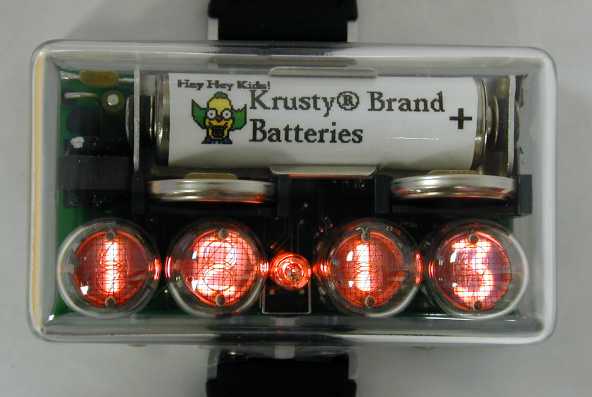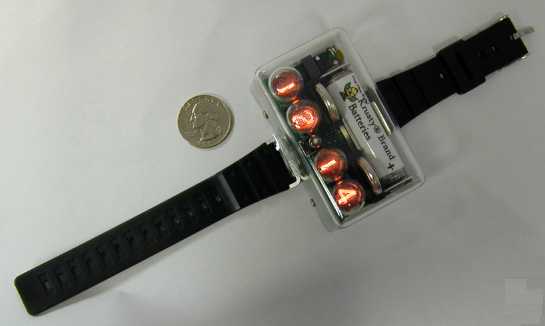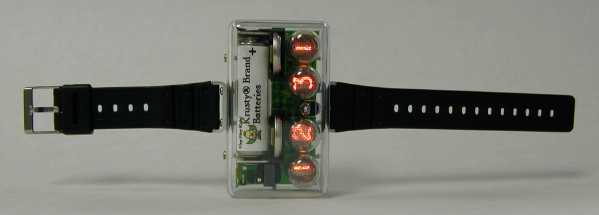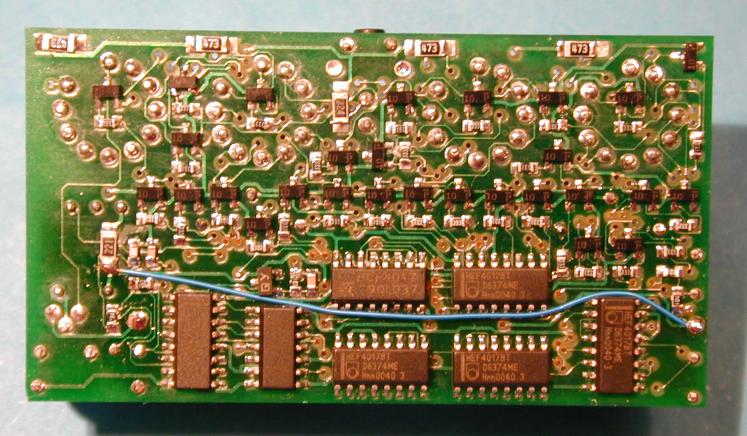What if LED and LCD display digital
wristwatches
had never been invented?
Here's what might have happened...
The Nixie Tube Digital
Wristwatch!

To view the time; simply press the
button on the
front of the watch to illuminate the Nixie Tubes.
Daylight viewing is good, and night time
viewing
is like an orange beacon.
Why a Nixie Tube Wristwatch?... well
because
it had never been invented before!
The wristwatch was designed using
surface mount
components, and miniature NOS (1960's vintage) Nixie Tubes.

The Nixie Tube Wristwatch is enclosed in
a transparent iWatch case :). You can view the miniaturized electronics
contained
inside.
The dimensions are only: 2.75"L x 1.5"W
x 1.2"H
it's very small (for a Nixie wristwatch).
If you appreciate the soft orange glow of
vintage
Nixie Tubes, then you'll love the Nixie Tube Wristwatch. - This is the
ultimate geekware -
Consider the fact that nobody else in
the
world has even seen a Nixie Wristwatch. It'll surely attract
attention when wearing it in public.
Twenty five nixie watches were assembled to sell, with each
wristwatch assigned a serial number. Own a piece of history for your
enjoyment.
Time is displayed in 12 hour format
only.
Time setting is accomplished using fast and slow increment buttons on
the
side of the enclosure.
Though the Nixie Tube Wristwatch is
enclosed,
it is not considered waterproof. And the glass
Nixie
Tubes can be broken if it is dropped.

It is amazing to see how the display
technology
from yesterday can be integrated with the miniaturized components
available
today...
The Nixie Wristwatch does not have a
microprocessor,
or programmed components. Standardized low-power CMOS logic drive the
nixies
in DC mode.
A number of different circuits were
considered
when designing the watch. I eventually settled on the simplified logic
approach, similar to the circuits used
when LED digital wristwatches were entering
the
consumer market around 1972. Of course, I couldn't place the circuitry
on one IC chip as they had done.
Viewing the underside of the Nixie
Wristwatch
at 5X. The compact circuitry and miniature surface mount components are
very interesting.

The 1.5v Alkaline AA display battery
will last
for more than six months if the time is displayed a dozen times per day
for a few seconds.
Two CR-2032 lithium batteries powering the
timekeeping
electronics will last approx 6 mos, regardless of how often the time is
displayed.
Price: $495.00 assembled. Sold
out long ago, sorry...
Would you like to have a "Krusty Battery" for your own project?
Click on the image below to download an image file arranged for Avery
8253 labels.

The story of the Christmas 2001 gag gift.
It all started in March of 2001. A friend had been visiting me, and
while he was looking at one of my Nixie Tube Desk Clocks, he asked
"could someone build a nixie tube wristwatch?". Evidently, his question
had came to him from a recent viewing of the movie "Brazil".
Laughing, I said that it would be impossible to cram the nixie tubes
and power supply into a package small enough to fit onto your
wrist.
A few months pass, and it is now June 2001 and I am sitting in
my office
with a few spare minutes, admiring the simple flash electronics
module from a disposable camera my wife had used. I noticed it could
supply over 200vdc at 1ma of current with just three components and
a single AA battery. Hey!, the nixie wristwatch might be a possibility
after all. A year or so before, I bought a hundred tiny Nixie
Tubes
at
an auction of surplus military stuff at Hickam Field in HI. They were
cheap, but much too small to use them in a clock. The miniature tubes
might indeed work in a wristwatch. It had to contain at least four
tubes to qualify as a real looking clock, but I could cram them all
together.
Thanks to the "Dot Com Deadpool", the semiconductor equipment
business
was in the tank. When July arrived, I had nothing on my schedule
and sat down at a PCB CAD station to began modeling the various parts
to see how compactly I could design a battery powered Nixie Clock.
I spoke with Roger Riehl (of Synchronar 2100 fame) by telephone
regarding
his design approach. Since the Nixie Wristwatch was supposed to
be a "missing link" that predated LED and LCD's wristwatches (tongue
firmly in cheek), it cannot contain an MCU or other programmed parts.
Roger built his amazing wristwatch using custom die attached to a
hybrid
carrier. The Nixie Wristwatch was intended as a gag gift at Christmas
for close friends, and so I didn't have the resources to assemble it
at the chip die level, considering production was limited by the tubes
on hand.
A few days pass and I had completed the circuit board design.
The circuitry
was simple, based on CMOS logic that was commonplace for the
brief period in history that the Nixie Wristwatch would have glowed
brightly. I had a single run of boards fabricated by my usual local
vendor.
Good grief, I could not believe I designed it so damn small. Everything
was surface mount, and some of the traces were less than .008" wide.
All the parts were assembled to the first five prototypes in August
2001. Amazingly, everything fit, and it actually worked! Now it needs a
case.
An associate in the plastics molding business had worked on developing
the enclosure from an example I provided him. His fee was a completed
wristwatch of his own. What? someone actually wants one of these silly
things? Could it actually appeal to others than my own geeky
nature?
At the beginning of September, five Nixie Tube Wristwatches
were completed
and running. Plenty of time to package these goofy holiday gifts!
Everyone who saw the watch laughed out loud, and then asked if I could
build one for them. Hmmm. Could I have a cult "sleeper"
item
here?
After it was all over, a total of 35 Nixie Wristwatches were
assembled
from available components on hand. Ten were given away at Christmas,
and twenty five were sold individually (some on Ebay) in the first
quarter of 2002. The little gag gift confirmed a Nixie watch had broad
appeal.
In 2010, I began working on a new version
of the Nixie Wristwatch.
If you would like to see what the second generation of Nixie Wristwatch
will look like, CLICK
HERE for more information.
Resonant Instruments LLC
tel 480-516-4523
Click
here to return to the Nixie Clock and Nixie Wristwatch site



